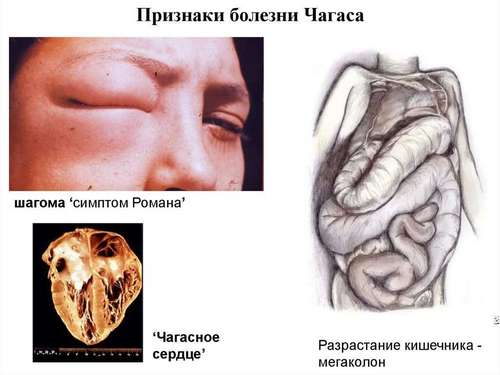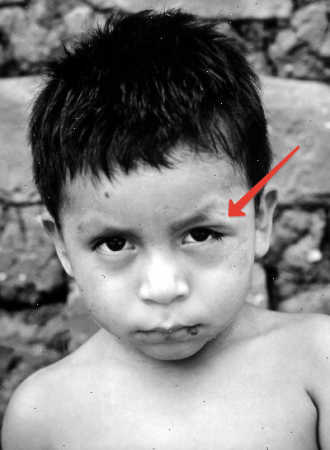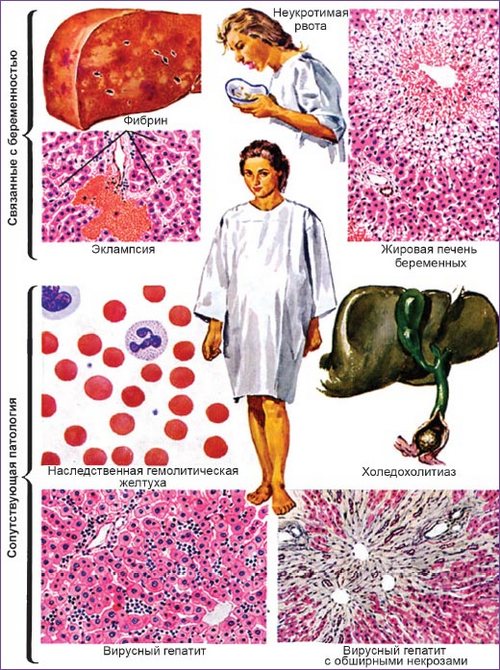Chagas disease – vector-borne protozoal infection which is the causative agent of pathogenic Trypanosoma cruzi, and the vector triatomine bugs.
The acute form of Chagas disease manifested by fever, headache and muscle pain, edema, rash, lymphadenitis, hepatosplenomegaly, cardiomegaly, and myocarditis, meningoencephalitis, chronic heart failure, megaezofagus, megacolon.
The diagnosis of Chagas disease based on anamnesis, clinical, microscopic, cultural and serological studies. In the treatment of Chagas disease used anti-parasitic drugs, symptomatic treatment, complications – surgical intervention.
Chagas Disease
Chagas disease (American trypanosomiasis) – protozoos caused by an intracellular protozoa parasite of the genus Trypanosoma (T. cruzi) leading to inflammatory and degenerative changes of the heart, nervous system, gastrointestinal tract.
Chagas disease is a natural focal diseases prevalent in almost all countries of the American continent: endemic trypanosomiasis areas are Central and South America. In rural areas, the majority of the population is infected with trypanosomiasis in childhood, is often asymptomatic infestation. Among those infected with Chagas disease is dominated by males.

Causes of Chagas disease
The causative agent of Chagas disease is the flagellate Trypanosoma cruzi, simple, complex development cycle which includes the change of the hosts – vertebrates and humans, and the specific carrier to serve blood-sucking bugs of the subfamily Triatominae (triatomine). T. cruzi has a spindle shape, flagellum, and unduliruûŝie membrane. The parasite goes through several life cycle phases: amastigote living tissue cells; epimastigote growing in the intestines of carriers; and trypomastigote in the blood of animals and humans. The main host of T. cruzi is people, extra – armadillos, anteaters, monkeys, and domestic animals (dogs, cats, pigs). The infective stage for the vector and hosts are trypomastigote form.
The infestation of bedbugs is in the process of feeding humans or animals, containing trypomastigote. In the human body the causative agent of Chagas disease will be logged along with the infected faeces of bed bugs by scratching their wounds after bites on the skin and mucous membranes of the lips, nose, conjunctiva. A characteristic feature of T. cruzi is the ability to intracellular parasitism in macrophages of skin and mucous membranes, in the cells of the myocardium, the endothelium of the lymph nodes, spleen, liver, lung, glia.
After the rupture of the affected cells, crowded multiplied by amastigote, is an infection of new cells. The parasite trypanosomes leads to an inflammatory-dystrophic and degenerative lesion of the internal organs. The most common way of Contracting Chagas disease – vector-borne, transmission is possible alimentary, sexual, transplacentally, by blood transfusion and organ transplantation. Characteristic for T. cruzi persistence in the host organism throughout life.
The symptoms of Chagas disease
The incubation period of the disease lasts 1-3 weeks. Then, in the place of penetration of trypanosomes may develop local inflammatory reaction (chagoma) in the form of erythematous node swelling and redness unilateral edema of the crimson century (symptom Rominii) with conjunctivitis, accompanied by an increase in regional lymph nodes. Chagas disease takes place in 2 stages: acute (first 2 months) with the circulation of a large number of parasites in the blood and chronic – with the concentration of trypanosomes in the internal organs.

In the acute stage of the disease Sigasa in most cases, symptoms are absent, some patients manifest themselves in the form of light. In children under 5 years of developing the most severe form with systemic manifestations and mortality rate of up to 10-14%. Among the common symptoms of Chagas disease may be a malaise, a constant or remitting disseminated fever (up to 39-40°C), headache, muscle pain, swelling in the legs, puffiness of face, small makalena rash. Typical cervical, inguinal and axillary adenopathy, hepatosplenomegaly. Can occur secondary Sagami – tight knots in the subcutaneous tissue.
It is noted the predominant lesion of the heart, Central nervous system and peripheral ganglia, organs of the reticuloendothelial system. Develops acute inflammation and enlargement of all chambers of the heart (cardiomegaly), diffuse myocarditis, violation of cardiac activity. Some patients (especially at children of early age) may experience acute specific meningoencephalitis, hemorrhage in the meninges. Congenital Chagas disease may lead to spontaneous abortion or premature delivery; in neonates accompanied by severe anemia, hepatosplenomegaly, jaundice, convulsions, and often death.
In the chronic form of Chagas disease, symptoms can be absent until there is irreversible damage to internal organs. Most often develop cardiomyopathy, manifested heart failure, arrhythmia, thromboembolism. From the blood characteristic abnormal enlargement of the esophagus (megaezofagus), manifested by dysphagia, pain on swallowing, and enlargement of the colon (megacolon), accompanied by intestinal obstruction, accumulation of fecal stones. Have autonomic disorders and peripheral neuropathy. Over time, Chagas disease can cause sudden death due to progressive destruction of the heart muscle.
Diagnosis of Chagas disease
Diagnosis of Chagas disease includes a thorough history (including place of birth of the patient, travel to endemic disease areas), analysis of clinical data and laboratory tests (microscopic and culture methods, serological tests and PCR).
As the test material is blood, cerebrospinal fluid, punctate from the primary affected areas, lymph nodes, spleen, and bone marrow. In the acute phase of Chagas disease (first 6-12 weeks) parasites can be detected by microscopy thick drops of blood or fixed stained preparations. Bacteriological blood cultures of the patient helps to identify the pure culture of T. cruzi. When of Chagas disease, xenodiagnosis is used, including a study of the intestinal contents neinfizirovanne triatominae bug after saturation with the blood of a patient. It is possible to conduct biological sample with the introduction of the patient’s blood Guinea pigs or white mice, and subsequent study of tissue samples.
In chronic Chagas disease more effective serodiagnosis: complement fixation reaction of indirect fluorescence, indirect hemagglutination reaction, ELISA. The presence of specific Dgavric about the acute stage of Chagas disease, with chronic available only IgG. Some infections, for example malaria, syphilis, leishmaniasis can give false positive results on trypanosomiasis, so it is recommended to use at least two independent methods of serological diagnosis. Needed differential diagnosis of pathogenic trypanosomes from non-pathogenic species, capable in the human body without causing the disease.
Treatment and prognosis of Chagas disease
To date, the treatment of Chagas disease is ineffective; therapy can reduce mortality among patients, but does not ensure complete eradication of the intracellular forms of T. cruzi. In the treatment of Chagas disease there are two antiparasitic drugs: nifurtimox and benznidazol, the reception of which is more effective in the acute phase of the disease. In the chronic stage of infection treatment is aimed at relieving the symptoms of complications of Chagas disease. In heart failure and arrhythmias, for the prevention of thromboembolic States are assigned ACE inhibitors, cardiac glycosides, antiarrhythmic agents, anticoagulants, in severe cases, coronary artery bypass grafting, implantation of pacemaker heart transplantation. Treatment of meningoencephalitis – symptomatic; gastro-intestinal lesions may be used corticosteroids; when possible megacolon surgical intervention: colostomy, colon resection.
The prognosis of Chagas disease depends on the stage of the disease, the severity of development and reversibility of inflammatory and degenerative lesions of the internal organs, age of the patient. Patients with late stage of Chagas disease, often die of acute heart failure, heart attack, stroke, early childhood, from acute and rapidly developed meningoencephalitis. Prevention of Chagas disease include insecticide treatment of houses, poultry houses, piggeries, of the main habitats of bedbugs as a vector of parasites and landscaping housing; selection and screening for trypanosomiasis potential donors of blood and organs, health education of the population.




Hey There. I found your blog using msn. This is a very well written article. I’ll be sure to bookmark it and come back to read more of your useful information. Thanks for the post. I will definitely return.
OKAY 🙂
Will you expand on these points?
The subsequent time I learn a weblog, I hope that it doesnt disappoint me as a lot as this one. I mean, I do know it was my option to learn, but I truly thought youd have something interesting to say. All I hear is a bunch of whining about one thing that you may repair if you werent too busy on the lookout for attention.
Your post comes across somewhat short-you’re usually ever so eloquent with your writing.
I get what you mean, but I have questions. Could we talk more?
Hey There. I found your blog the use of msn. That is a really smartly written article. I抣l make sure to bookmark it and return to learn extra of your useful information. Thanks for the post. I抣l definitely comeback.
Thanks for the excellent post